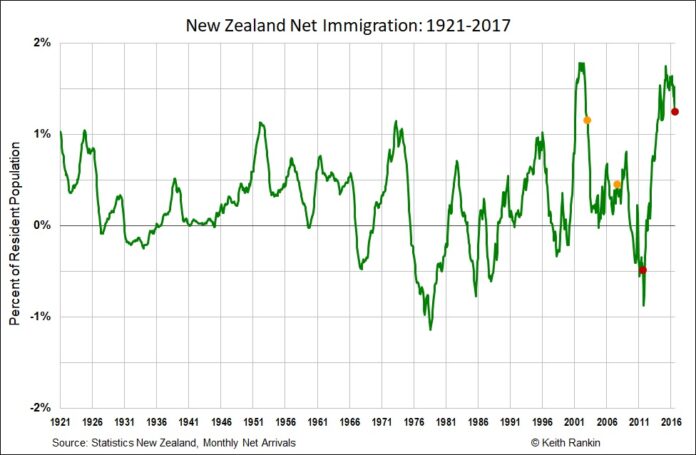Analysis by Keith Rankin: New Zealand Net Immigration from 1921.
This month’s chart shows the only factual measure of net immigration: total arrivals in New Zealand minus total departures. It measures annual net passenger flows as a percent of resident population, using monthly data. The most recent figure, for the year ending July 2017, shows a net inflow of 59,842; which is 1.25 percent of New Zealand’s resident population.
Net immigration is a very good indication of safe employment opportunities in New Zealand relative to opportunities elsewhere. It is generally well-synchronised to New Zealand’s economic growth cycle. This century has seen post-1920 peaks, in 2002 and 2014‑16. 2002 clearly followed the New York and Washington terror attacks in 2001. 2014‑16 also strongly reflects security and economic concerns in much of the rest of the world.
The chart marks the two most recent property booms in the Auckland (and subsequently New Zealand) residential land markets: 2003 to 2008, and 2012 to 2017.
The first boom is demarked by the gold spots, the second by the red spots. The general picture is that such booms are unrelated to immigration. In the first 21st-century boom, initial immigration appears to be incidental. As the boom progressed, net immigration fell and stayed low until 2009. This property boom took place under conditions of generally high (and rising) interest rates.
The second property boom got underway in 2011 at the end of a near-decade of low net immigration. Net immigration became significantly high only in 2014, well after the beginning of the Auckland property boom. This boom took place in a low (and sometimes falling) interest rate environment. Neither immigration nor interest rates serve as plausible explanations for the Auckland land-price booms.
When we go back in time, we see that net immigration closely reflects a stuttering economic cycle. In 1929‑30, there was significant immigration from Australia, where the global economic depression struck. This was more than two years before the summer of 1930/31 when it struck New Zealand. During the Depression, both immigration and emigration were very low. A construction boom in 1937‑38 restored high levels of immigration, especially workers from Australia.
New Zealand’s post‑war immigration peak was in 1952‑53. Immigration was also strong in the early 1960s and early 1970s. Robert Muldoon became Finance Minister from early 1967 to late 1972. Difficult years for New Zealand gave way to good years.
It is true that net immigration collapsed in Robert Muldoon’s first trimester as Prime Minister. This is when many later post-war baby-boomers (born in the 1950s) took the opportunity to enjoy their OE, while New Zealand got the world recession later than most other countries. Many of these people came back during Muldoon’s third term government, from 1981 to 1984. In those years New Zealand was continuing to liberalise (many liberal reforms – such as divorce laws, shop-trading hours, and open information – took place then). These were the years when returning New Zealanders contributed to growing movie-making, information technology, and restaurant-café growth. They were also years when New Zealand looked very pleasant from Thatcher’s new Britain and America’s experiment in Reaganomics.
Net immigration was negative during the period of the Lange-Douglas Labour government, a period of rapidly growing house prices despite emigration and high interest rates. Immigration resumed in 1991, when Australia had its financial crisis (ours began in 1987). Rising immigration in the mid‑1990s coincided with another residential property boom, though probably did not cause it. (Rising income and wealth inequality is in fact the root cause of land-banking mania. 1985 to 1995 was the period in which New Zealand transformed from an equal to an unequal society.) The late 1990s saw a general economic stasis, with changes in China and the USA eventually facilitating the growth boom of the 21st century.
New Zealand is a migrant nation. Immigration and emigration have always featured strongly in its economic and social history. Recent events are no exception. However, while New Zealand has a high population turnover, most people who have identified as New Zealanders remain Kiwis at heart.
What of the 2020s? I think that, for New Zealand, they will prove much like the 1920s. New Zealand will stutter as the world economy slowly implodes.








